#Structured Cabling Industry
Explore tagged Tumblr posts
Text

#power lines#transmission structure#my photo#high voltage#industrial#industrial photography#photography#landscape#landscape photography#laminated wood#fiber optic cable#sky
6 notes
·
View notes
Text
Maeda Meet Cute

A Keiji Maeda red thread of fate story for @scruffymctee for the occasion of her birthday ^_^ Featuring her lovely OC Tomoyo. Approx 2000 words of modern AU fate, love, and kisses!
Keiji wiped the sweat from his brow with the back of his hand. It was a warm day, bright sun and a hint of a breeze. Shame, he thought, to spend it working like this. But needs must. He pulled his sweat-soaked shirt off and hung it off one of the bare planks jutting from the side of the building.
"Showing off again, boss?" One of the guys shouted from his spot up on the scaffolding.
"Always," Keiji laughed. He kept a smile on his face for the crew. All day, every day. In work like this, morale meant everything. Happy men made for better workers. Besides, his misery was his own. They didn't need to know. "Besides, it's hot," he added. "I can't believe it's only May!"
"Be a rough summer," the guy agreed.
"Now stop watching me and pay attention to the damn crane," he shouted up at the workers. The building project Keiji managed was scheduled to complete in August. It was a beast of a job, but worth it, if they could make the deadline. He felt fairly confident they would. No matter what kind of failure his family thought him, he had a good reputation in the industry. He was the guy you hired when your building had to be done by a certain date, within budget. Keiji hadn't failed a project yet, and wasn't about to start.
He might never be famous, but damn if he wasn't going to be the most successful construction company in the country. The crew he'd built, his network of suppliers and contacts, his reputation . . . it would all . . . Keiji's thoughts scattered as an odd tingling swept over his skin. He felt as if a cool breeze kissed his bare chest and back, raising the hairs on his arms.
Keiji glanced around, wondering if anyone else on his crew felt the same. If they did, their faces didn't betray it. He bent back to work, but the sensation persisted. Keiji kept looking up, distracted and a little confused. That was when he spotted her.
She was gorgeous. Long dark hair pulled into a loose braid over her shoulder, eyes that flashed emerald green in the afternoon sun. Lips as red and sweet as ripe pomegranate seeds. Her curves were hardly concealed by the playful sundress she wore. The woman was lounging beside a drink cart. Her fingers were curled around the neck of a glass bottle, little droplets of condensation glittered on her skin from the cold drink.
Her eyes met his as she lifted the drink to her lips, and never in his life had he wished to be a bottle more than at that moment. There was something irrepressibly sensual about her that made his face hot and sent a pleasant shiver down his spine. He grinned at her and winked.
The woman smiled back. Then, she let her eyes travel up and down Keiji's body. He could feel her gaze, as if she were trailing her fingers along his chest and the fly of his jeans. Keiji licked his lips, feeling suddenly exposed.
"Looks like you've got an admirer, boss," one of his crew commented with a chuckle.
"Something like that." Keiji cleared his throat, trying to bring himself back to the moment. So what if a beautiful woman gave him a once-over. It wasn't like this was a first. It meant nothing. He pulled himself away, turning back toward the building. He could still feel her eyes on him, that phantom touch caressing his shoulders and the small of his back.
Keiji tried to ignore the sensation, even as it drew him toward her in a way he could not explain. His eyes travelled over the work site, avoiding the woman, checking the safety measures as his crew began one of the more dangerous parts of their job. Hoisting structural supports to the upper floors.
"Hey, watch that I-beam!" Keiji shouted up at the crane operator. Several tons of steel swung up over the scaffolding, titling precariously. The area beneath the hoist was clear, but the crane cables were swinging more than he liked.
"We got this," his crane operator called back. The prediction came a moment too soon. A sudden gust of wind at the top of the structure made the beam swing out wildly. The heavy steel tore free of the crane cables and tilted, first one direction, then another. Its shadow careened over the ground, predicting all the places it might come crashing down.
This wasn't the first time Keiji saw such a mishap. As the I-beam slipped free of the last restraint, he saw where it would land. Atop the woman, who was still watching him. Her expression betrayed not a hint of dismay. Keiji didn't pause to shout a purposeless warning. He lunged toward her, knocking her out of the path of the falling steel. His body twisted to protect her from the hard asphalt and concrete beneath them.
The world shook for a moment as the I-beam landed with a deafening crash. Keiji and the woman were only inches away, lying half on the sidewalk, half on the street. The remains of her sweet soda slowly soaked into Keiji's jeans. He barely noticed. His full attention was on the woman.
He could smell her, a scent unlike any perfume. It was warm and summery, with just a hint of cinnamon spice beneath. Her hair tickled his face where it had come loose from the braid. She fit against him as if they were molded together. The curves and hollows of her body pressed into his own perfectly. Though she was safe now, he found himself reluctant to let go. "You should watch where you're standing, princess," he murmured, trying to play his reaction off as something other than attraction.
"Maybe you should watch where you drop your things." She arched a brow, unphased by the near miss and the intimate contact. Her nails trailed lightly down the outside of his upper arm. "Somebody might get hurt," she added, her lips curling in a slight, playful smile as if she'd made a joke.
"You could have been," he retorted, feeling all out of sorts. His heart was pounding harder now than it had been when he leapt for her. Somehow, the idea of this stranger being injured set a panic in him.
The woman gave a slight shrug. "I knew I'd be alright."
Keiji couldn't help but grin, though it was out of exasperation as much as amusement. "So you just expect random people to jump to your rescue?"
"Nope. Just you." She nibbled her lower lip for a heartbeat, as if considering whether or not to say more. "I just knew you wouldn't let me get hurt. It's weird but . . ." Her gaze fixed on his. "I feel like I know you?"
Though she spoke the words with a questioning lilt, Keiji knew it wasn't a question. He felt it too. Down to his bones. He didn't even know her name but holding her like this felt natural. Like he'd been doing it his whole life. "Yeah."
People were crowding around now, and he knew he should let go. Help her up. Check the damage to the beam and the worksite. But he couldn't bear to let go. Not yet. "What's your name?"
"Tomoyo." She smiled. "And you are?"
"Keiji. Keiji Maeda."
She repeated his name, savoring the syllables. "We should probably get up," the woman added. She made no move to follow through.
There were sirens in the distance, coming closer with every breath. In no time at all, he'd need to be looked at by emergency services, and begin the unpleasant task of getting the work back on track. "Tomoyo." He liked the way her name sounded, liked the flicker of heat in her eyes when he said it. "Can I get your number?"
Tomoyo grinned. "Only if I get yours too."
Only then did Keiji stand, still cradling her to his chest. He set her on her feet and released one arm, though the other still curled gently around her back. "You ok?"
"Yes." She had a smile he could only call challenging. "Thanks for saving me, Keiji."
He was going to toss out some half sarcastic, witty reply, but before he could, she lifted onto her tiptoes and brushed the lightest of kisses to his lips. His mind emptied of everything but her. The feel of her, the sweetness of her lips. The faint taste of strawberry from her drink, and Tomoyo, even sweeter beneath that.
Keiji wanted to crush her to him, to kiss her breathless. To carry her off like some romance novel hero, to make love in a mountaintop castle worthy of a woman like her. He wanted to drown in her passion. To make her say his name, to moan it, while he buried himself in her. Keiji had never wanted anything so much as he wanted more of Tomoyo. But the emergency services were pulling up and the world was already breaking into this moment between them. Pulling them apart. Asserting the bald, sharp face of reality against the pleasure-dream.
He let go. She stepped back. The two of them were swarmed a moment later, phone numbers forgotten in the panic of the aftermath. Medical services checked them over, along with anyone else in the accident's general area. The construction crew poured out of the worksite, hemming and hawing about the crane and the wind and what to do next.
There was so much to worry about, so much to do. Keiji tried to catch sight of Tomoyo through the throng, but couldn't find her. His body ached for her closeness. Absurd, he thought. But true nonetheless. It was as if a string tied tight around his heart, and every moment away from her it drew tighter.
Then, with no warning she was there, pushing something into his hand. Her satin-soft fingertips pressing against his calloused palm. A shred of paper. "Call me," she mouthed. And then she was gone again.
"To hell with that." Keiji stood from the spot the medics left him. He pushed past his crew and the emergency responders. "Tomoyo," he shouted. "Tomoyo!" Keiji spotted her sundress, her graceful limbs, the now-tangled sway of her braid. He ran toward her.
Tomoyo turned as he closed in. "Keiji?"
"I don't want to call you," he admitted. There was a flash of hurt in her eyes, and he reached out to take her hands. "I don't want to be that far from you."
She blinked up at him, confused. "I don't understand."
"Come home with me? Or let me come with you? I'm-" Keiji paused, not sure if he should admit more. They barely knew each other, after all. But in for a penny, in for a pound. "I'm not ready to let you out of my sight. Not now, when I've just found you."
A smile slowly lifted the corners of her lips. "Bold of you, Keiji Maeda. What would you do if I said no?"
He knew she wouldn't. Not with that heat simmering in those jade green eyes. "I'd have to find a way to convince you."
Tomoyo laughed. "Is that so? And how would you convince me?"
"I could sing? Dance?" He dropped to his knees. "I could beg."
"Or you could kiss me," she counter-offered.
"Or that," he agreed, pulling her down to him. His lips met hers and this time it was no light brush. Her lips parted with a gasp as his arms went around her, hands tangling in her dress. His tongue teased past those sweet candy-red lips and into the sacred mystery beyond. Tasting, toying, exploring her. And she kissed him back, every bit as hungry for more of him as he was for her.
Keiji wanted to keep his eyes on her, but the feeling was too overwhelming. His body felt as if it was on fire, as if his heart was ready to burst. His eyes closed, flickers of light forming in the darkness behind his eyelids. The light was green as emeralds. Green as jade. Green as the color of Tomoyo's eyes. He could feel the rapid beat of her pulse, the flutter of their shared breath.
He stood, lifting her up as he did. Breaking the kiss to call back to his workers. "I'll see you tomorrow!"
Tomoyo gave them a cheeky wave as they left to the sound of joyful laughter and confused questions. Between them, there was no confusion. There was only an undeniable connection. A thread woven between them, unbreakable, and drawing tighter every moment. Keiji was afraid to use the word love, but he didn't need to think it, to say it, to know it was true. In time, it would come of its own accord, admitting with a breath what they both felt.
#ikemen sengoku#ikesen au#ikesen Keiji#keiji maeda#red thread of fate#fanfiction#fanfic#otome#otome guys#fluff and light spice
32 notes
·
View notes
Text
The Voyages of the Padua
Chapter 5
(1, 2, 3, 4)
Cass emerged from the shower booth only to be met with a blank holoplex. No, not quite blank. Ria had created the illusion of a sheet of paper taped to the plex on her side. It simply said “BRB” in big letters… whatever that meant.
Cass was alone. Again.
Technically, she supposed Ria was everywhere there was one of the holoplexes, but with her attention elsewhere for the moment. And the rest of the crew had to be somewhere nearby. But they weren't here.
She wasn't confined. There was no one to escort her. She apparently had free reign of the ship? It seemed like terrible security posture… unless they didn't see her as any kind of threat. Should she be insulted by that?
She was overthinking again.
She took a breath and stepped into the corridor. It was such a stark contrast to the Eosphorus. Where the other ship had been all clean bright paneling and recessed lighting, the Padua was an assortment of exposed pipes and cabling and grated floorings. It was certainly more functional than aesthetic, though functional might have been a bit of a stretch given the number of ad hoc repairs and mismatched bulkhead panels Cass passed.
The environmentals were comfortable at least, not too dry, not to humid, maybe a little warmer than it needed to be, but within reasonable limits. It smelled… used, lived in. Something in the scent triggered some innate response, a pang of nostalgia for a place she had never been. Maybe she had served on a ship like this in her previous life?
And then there were the noises. Those ever present sounds that had lulled her out of her slumber were even louder out here in the corridor. The Eosphorus seemed the sort of ship designed to run quiet, noises were meant to signal danger. Here, silence was the danger.
As she meandered down the hall, she realized at least some of that noise was music. Or at least she thought it was some sort of music. It was a sort of glitchy industrial ambient, with only the barest hint of rhythm or melodic structure.
She followed the source of it, rounded a corner and there was Mina.
Mina had tied the arms of her jumpsuit at the waist, leaving her torso covered only by a loose tank top that hung on her elongated frame. She had an access panel off one of the bulkheads and had her head and arms buried in the enclosed space beyond.
Cass watched as Mina blindly grabbed a tool from her belt and reached back in to tweak something or other. Taught muscles rippled under mottled gray skin with patterns that were constantly shifting with the music and occasionally bright little nodes of bioluminescence glittered along predefined paths.
She drew her head out and wiped at sweat on her forehead with the back of her arm. She had a long braid of black hair, threaded through with streaks of silver, held out of her face by a red kerchief that rested behind her large batlike ears.
One of those ears twitched and she glanced at Cass, finally noticing her. Whatever she was expecting to see, it wasn't Cass because she jumped in surprise, clumsily fumbling the spanner in her hand.
Reddish yellow beads of light flashed in patterns along her skin as she hunched her shoulders as she had on Eosphorus. She averted her gaze, only sneaking quick glances at Cass.
“Um… hi,” Cass said with a tentative wave. “Mina, right?”
Mina made a small nod.
Her face was almost human, but with a slightly flattened, almost catlike nose, and the seams of her jaws extended past the edges of her lips. And the large eyes that Cass originally thought all black, were actually shot through with a dark red around W-shaped pupils.
“I'm Cass,” she said, trying to shove down any lingering terror. “I mean, as of like 20 minutes ago. Ria kind of put me on the spot…”
Oh she was rambling. Just get to the point, she told herself.
“Um… thanks for saving my life,” she said.
Mina's lips quirked in a tiny smile and she ducked her head in acknowledgement.
“And I guess thanks for grabbing my bag. I really appreciate it.”
It was a shot in the dark, but it hit the mark judging by the way the pattern on her skin shifted, adding patches of a sort of greyish reddish pink that Cass could only assume was a blush.
Mina made a gesture. No, it was a sign for a word. Something casually negative. It's nothing. De nada.
It took a moment for Cass to parse the meaning and Mina made an apologetic smile and tapped her throat.
“Oh,” Cass replied. “I'm sorry, I didn't-”
“Mina!” someone shouted from down the corridor that Cass had come from. “Mina! Our guest is missing… ah.”
Cass recognized the other human. Tre. They were dressed just as impeccably as before, the collar and rolled sleeves of a bright white wrap shirt arranged just perfectly. Their olive skin was flawless, dark hair once again pulled back without a single strand out of place. Vivid purple eyes that couldn't possibly be natural swept over Cass dispassionately, as if she were a rather unremarkable insect.
“Fucking hell,” they said, equally dispassionately. “Ria was supposed to keep an eye on you.”
“I'm sorry,” Cass replied, slightly taken aback. “She showed me the shower and when I got out, she was sort of… gone?”
“I swear on the spirits,” they muttered. “If she's off modeling cathedral acoustics again…”
Mina interpreted them with a gentle tap to the arm.
She signed rapidly, more rapidly than Cass could follow, but she did catch a series of gestures that corresponded to letters: “C-A-S-S”
Tre looked back at her, somewhat more appraisingly this time.
“Cass, huh? So you remembered your name?”
“Uh… no,” she admitted.
“Oh hell, you didn't let Ria name you, did you?”
“Not…exactly.”
On cue, a familiar voice crackled over the intercom.
“Heeeeeey, friends! Aela's starting to wake up and she's probably going to wanna have a meeting. Also it's breakfast time and I'm hungry.”
Mina huffed an amused sound and Tre rolled their eyes.
“No, you're not,” Tre snapped back. “You don't eat.”
“Well duh,” Ria responded. “Obvs not. But breakfast is the most important meal of the day and Aela says I have to make sure you don't miss it again.”
Tre grumbled something under their breath, but apparently complied, trudging their way down the hall.
Mina offered Cass a shy smile and a gesture similar to the one she had made back on the Eosphorus.
“Are you coming?"
The mess turned out to be little more than a glorified kitchenette adjoining a multipurpose communal space with a table set against one of the bulkheads.
There was another sheet of holoplex where the table met the wall and beyond… some kind of mirror image of the room, only it was tailored to what Cass had to assume was Ria's personal aesthetic. Everything was pastels and glitter, with tacky throw pillows and kitschy art.
Tre wandered to the kitchen area and began making themself busy with breakfast. Meanwhile Mina slid into a seat at the table and pulled a data tablet out of a pocket in her jumpsuit and began scrolling.
Before Cass could determine whether she was supposed to sit or where, Aela staggered into the room. Her hair was mussed and her eyes were lidded, and she wore nothing but a pair of underwear and an oversized t-shirt that read "I'm not the step dad, I'm just the dad that stepped up".
Ria had mentioned something about the captain needing to recover after the drift (whatever that was), and the android did appear to be very out of sorts, practically hung over.
"Um... Captain-"
"Mm-mm," Aela cut Cass off with a raised finger and slumped heavily into the seat across from Mina.
Cass slipped into one of the remaining seats and watched in fascination as Tre fetched a mug from a cabinet and filled it with an unnaturally vibrant green liquid from a dispenser labeled "Aela juice: do not drink".
No words were exchanged as Tre set the streaming mug down in front of Aela. The whole routine felt practiced, familiar. This was a crew that seemed to know each other on some deep, intimate level. The whole thing made something deep within Cass ache.
Aela took a sip of whatever “Aela juice” was and made an appreciative grunt. Then she cracked her eyes open to peer blearily around the table.
Her gaze swept over Cass, seemed to notice something and cleared her throat.
Tre sat down, noticing nothing amiss, and began sipping at their own mug. The scent of strong coffee and whatever aromatics were in Tre’s breakfast, made Cass’s stomach growl.
Aela cleared her throat again, earning a confused “huh?” from Tre. Aela sighed and pointedly looked between Tre’s coffee and breakfast and Cass's lack thereof.
“There's coffee in the dispenser over there,” Tre grumbled, gesturing vaguely in the direction of assorted apparatus embedded in the wall of the kitchenette. “Mugs are right above. Don't drink from any of the labeled ones. Auto-chef does algae and yeast cakes. Don't select recipe 135, the aromatics are from a limited batch. It's mine and off limits.”
“Thanks,” Cass replied, maybe more to Aela than to Tre.
Auto-chef turned out to be a somewhat intimidating touch screen interface (again with a pair of googly eyes glued just above). It boasted 26 base recipes with infinite customizability. It was all some combination of yeast, algae, nutritional supplements and aromatics, so Cass figured “infinite” was probably a bit of a stretch. Fortunately (or possibly unfortunately), it featured an option labeled “surprise me”. She selected the surprise and hoped for the best. Given how hungry she was, it probably wouldn't matter.
The coffee maker was significantly less enigmatic. Coffee, black, unsweetened, hot, perfect. Present-tense Cass had never had coffee before, but past-tense had very clearly relished it judging by the satisfied grin the aroma brought to her face.
She turned to glance back at the table and hefted her mug in Mina's direction.
"Do you want any..."
She trailed off at Tre’s urgent gesturing over Mina's shoulder. A frantic hand sliced over the throat. Stop.
Cass had committed some manner of faux pas, but what exactly, she couldn't begin to guess.
Mina hunched her shoulders (she did seem to do that a lot) with an uncomfortable expression on her face.
"No, thank you," she signed. "I don't drink coffee."
At least that was the gist of the signs. Cass wasn't familiar enough with the dialect to understand perfectly, but she got the message.
As she carried coffee and algae cake back to the table, Ria joined them. She perched on a virtual stool in her holoplex, legs crossed with an oversized bowl in her lap. But rather than cereal every spoonful was full of oscillating abstract shapes that occasionally clipped through the bottom of the spoon. Cass could just make out the box at one of Ria's elbows that read "Möbius O's!"
Ria met Cass's eyes and gave a wink and a cheeky grin.
“So…” Aela said finally, bringing Cass’s attention back from Ria's pastel mirror universe. “What are we going to do with you?”
#my writing#writers on tumblr#the voyages of the padua#original fiction#original characters#science fiction#scifi
39 notes
·
View notes
Text

MAGA is more than a political movement—it’s a symbolic system that answers dislocation with identity, confusion with clarity, and loss with belonging. If we want to push back, we need more than critique. We need a new story—and the civic infrastructure to support it.
When we talk about MAGA, the temptation is to simplify—reduce it to ignorance, racism, authoritarianism. And while those elements are undeniably present, that simplification blinds us to the layered reality of what we’re facing. MAGA is not a single ideology. It’s a fractured but potent worldview, stitched together out of fear, loss, and an offer of belonging.
There are openly authoritarian factions: white Christian nationalists, neo-Nazis, and political opportunists who see democracy as an obstacle to power. There are loyalists who have traded constitutional principle for partisan control. But beyond that are millions of Americans drawn in by something less clear-cut: a sense that the ground beneath them has shifted and that no one in power seems to notice. For many, MAGA isn’t about policy at all—it’s about feeling seen.
From an anthropological perspective, MAGA functions as a symbolic system. Its power lies not in legislative detail, but in ritual, narrative, and identity. Flags are flown not just in support of a candidate, but as declarations of meaning. Rallies become performances of grievance and imagined redemption. Slogans operate like shared prayers. It’s not politics in the traditional sense. It’s belonging in the face of dislocation.
This dislocation isn’t imaginary. It’s rooted in real structural shifts. The collapse of industrial jobs, the erosion of social mobility, the fragmentation of public education, the disappearance of local media—all contribute to a pervasive sense of loss. Add to that climate disasters, housing precarity, and the stripping of rural and working-class communities by extractive economics, and you get fertile ground for stories that promise a return to order—even if that order is cruel.
The “stolen America” narrative—amplified by cable news, talk radio, and algorithmic social media—offers a simple explanation: you are losing because others are taking what’s yours. It’s a lie, but a compelling one, because it replaces confusion with clarity. It locates blame. It gives identity to those who feel erased.
If we want to counter this narrative, we need more than facts. We need a coherent, grounded, and emotionally resonant alternative—one that offers a place to stand, not just something to reject.
That counter-narrative might begin like this:
You matter—not because of your income, education, or politics—but because you are part of a shared society whose future depends on all of us.
This country has been sold out by those who put profit before people—by corporations and political elites who abandoned communities while insulating themselves from the consequences.
The struggle isn’t between neighbors. It’s between those who extract and those left to carry the cost.
Democracy isn’t about shouting the loudest. It’s about showing up—for your neighbors, your community, and the shared spaces that hold us together.
Patriotism isn’t about who you exclude. It’s about what we build together, and who we refuse to leave behind.
But a story is only as strong as the infrastructure that supports it. And this is where we’ve fallen short. Over the past four decades, many of the institutions that once mediated American life—unions, local newspapers, public schools, even churches—have been defunded, privatized, or politically captured. Into the vacuum stepped commercial media, political spectacle, and ideological silos. The storytellers changed—and so did the story.
We can’t rebuild a democratic culture without restoring its civic infrastructure. That means supporting local organizations that build trust, not division: libraries, mutual aid groups, community centers, labor cooperatives. It means creating spaces where people participate in shared projects that don’t rely on political affiliation—repairing parks, planting gardens, running food banks.
Rebuilding democracy also means widening the circle of belonging. Authoritarian movements draw power by narrowing it—by telling us who counts and who doesn’t, who belongs and who must be cast out. But if we are serious about renewal, we need a deeper ethic. One that recognizes the interdependence of all people, communities, and even the living world we inhabit. A culture grounded in care—across lines of race, class, faith, geography, and species—isn’t idealistic; it’s necessary. We cannot meet this moment with sharper divisions. We need a broader sense of connection, one that makes solidarity feel not just moral, but natural.
It also means recognizing who carries informal authority in our communities. Teachers, nurses, veterans, clergy, small business owners—these are the people who can reach across narrative divides, not with slogans, but with lived credibility.
We must also shift what we reward. Our current information economy privileges outrage and spectacle. But social capital can be directed elsewhere. Let’s elevate those who mediate, who mentor, who build—those who quietly embody the kind of society we say we want.
Democracy doesn’t live solely in Washington. It lives—or dies—in every community. In school boards and union halls, neighborhood councils and library basements. It thrives when we practice it, and withers when we stop showing up. If we want to resist authoritarian narratives, we can’t wait for national leaders to save us. We have to rebuild the culture and practice of democracy from the ground up—not just as an ideal, but as a lived experience.
This doesn’t mean everyone can be reached. Some are too deeply invested in grievance, or too entangled in conspiratorial thinking, to engage in good faith. But many others are simply trying to make sense of a world that no longer feels coherent. For them, the challenge isn’t persuasion—it’s providing another path to belonging.
The story of America is contested, as it always has been. But the storytellers have changed, and the stage has fractured. What we’re witnessing is not just a political fight—it’s a cultural realignment. The real battle is over meaning: who belongs, who decides, and what kind of future is worth building.
If we want to meet this moment, we need more than policy proposals. We need a public narrative rooted in dignity, care, and shared responsibility—and we need the material conditions that make that story believable. The vision is already out there, scattered across movements, communities, and everyday acts of solidarity. The task now is to gather those pieces, name them clearly, and begin again.
James Greenberg
Understanding MAGA: Rebuilding Democracy
15 notes
·
View notes
Text
top 10 industrial noises
loud deep metal groan
steel beam bending loud creak
high tension cable snap
metal structure collapse
i-beam deform under pressure loud groan
power line movement in wind
ac electric motor startup
large metallic sheet bend and groan
factory mechine deep rumble
electrical equipment transformer substation hum
11 notes
·
View notes
Text
Unpunished evil returns and grows stronger in its impunity

"13 houses in the residential area were damaged during the rocket attack, the houses have five floors. There is a very large number of broken windows, over 700. Seven humanitarian buildings were damaged," said Kateryna Yamshchikova, Secretary of the Poltava City Council, about the consequences of the missile attack in Poltava on June 17.
Utilities and rescuers are working at the site. They are trimming damaged trees and removing balcony structures. Social workers and psychologists are also assisting.
Also, Vadym Labas briefly explains why certain countries that arrived at the Global Peace Summit in Switzerland did not sign a joint declaration.
▪️ Saudi Arabia is a major hub for the transfer of components and units for Russian weapons, as well as a place of accumulation of billions of Russian money. ▪️ India - supplies units and components to Russia. It has joint military-industrial complex plants with Russia, from assault rifles to missiles. It is a hub for transshipment of Russian oil. ▪️ South Africa - everything is clear here: "Wagner", money and influence. ▪️ Thailand - supplies sanctioned products to Russia and also helps the Russian military-industrial complex with its production. For example, Russia could not produce cable products without Thailand. ▪️ Indonesia - supplies sanctioned products to Russia. ▪️ Mexico is a huge hub for the supply of drugs to Europe and Russian agents to the United States, which generates huge shadow earnings. ▪️ United Arab Emirates - helps to supply sanctioned products to Russia and has a lot of Russian money. ▪️ Armenia - has a huge Russian lobby and is one of the key players in the supply of smuggled military-industrial products to Russia.
All this brings super-profits either to these countries themselves or to influential clans in these countries. Therefore, they are quite satisfied with the current situation.
P.S.: these countries came to the Summit to "keep their finger on the pulse," but they are not interested in peace in Ukraine because they make super profits by helping Russia circumvent sanctions and supplying components. But if they were given a clear signal about the secondary sanctions that could be imposed for helping Russia, their "pulse rate" would increase significantly.


DPRK prepares for the arrival of the world's evil.
Now the most important news: The ratio of forces in the Pokrovsk sector is 1 to 7 in favor of the Russians, said a soldier of the 47th Brigade, pseudonym "Azimuth".

Photo: Approximate front line in the Pokrovsk sector/DeepStateMap.
The Russians are pressing near the villages of Novoselivka Persha, Sokil, and Novopokrovske, trying to reach the Pokrovsk-Konstantynivka highway.
Don't be indifferent. Make Russia pay. Please hear our cry out to the world, keep spreading our voices, and donate to our army and combat medics (savelife.in.ua, prytulafoundation.org, Serhii Sternenko, hospitallers.life, ptahy.vidchui.org, and u24.gov.ua).
#ukraine#poltava#donetsk#genocide#stop the genocide#russia is a terrorist state#russian invasion of ukraine#russo ukrainian war#make russia pay#russia must burn#war in ukraine#current events#world news#important#signal boost#stand with ukraine#donate if you can#please donate#donations#український tumblr#український тамблер#arm ukraine
38 notes
·
View notes
Text
Spending Our Childhood with Cartoon Network—Reflections on Its Golden Era and the Streaming Age
Who didn’t grow up watching Cartoon Network (CN)? That checkerboard logo wasn’t just background noise; it felt like an imaginary friend who grew up alongside us. From Dexter’s Laboratory and The Powerpuff Girls to Cow & Chicken, Johnny Bravo, Samurai Jack, and Ed, Edd n Eddy, and a little later, Ben 10, Adventure Time, Regular Show, and Steven Universe—these shows painted some of the most colorful dreams in our childhood memories. Even now, decades later, any mention of that era can still light a spark in our hearts.

Cartoon Network was something you “grew up with.” In its heyday, it wasn’t just about kid-friendly slapstick; it wove in dark humor, bizarre visuals, and unexpected social satire. We probably didn’t catch all the cultural jokes at the time, but that blend of “adult humor hidden in a cartoon” gave the network a depth that far exceeded any simple age rating.
We didn’t walk away scarred, either. In fact, learning to laugh at the weird, the absurd, and even occasional gloom taught us a certain kind of humor and resilience.

But after Steven Universe ended, as streaming services replaced cable and as cultural conversations became more sensitive, I suddenly realized I no longer felt excited about new Cartoon Network shows. It’s not just “getting old and abandoning cartoons.” The channel’s vibe has changed.
Today’s Cartoon Network seems even more “preschool-friendly” than before: brighter colors, faster pacing, safer themes, and a narrower age target. The only corner that feels like the old spirit lives on is Adult Swim. Can CN still “breathe” as it once did? I hope so, but it clearly isn’t the CN of our youth anymore.
Progressive Ideas Behind the Scenes
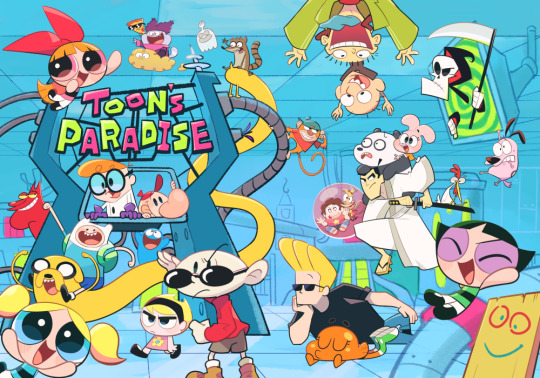
Many people complain that modern cartoons are too “politically correct,” but back in Cartoon Network’s golden age, several shows already carried deep progressive messages—without resorting to heavy-handed messaging or check-the-box storytelling.
Take Courage the Cowardly Dog. On the surface, it’s a creepy, surreal cartoon about a pink dog who cowers in fear—but Courage’s refusal to fit the mold of a “traditional male hero” was revolutionary. He isn’t strong, he’s not a fighter, and he’s riddled with self-doubt. Yet he finds the courage to protect his owner, Muriel, every time. His heroism is driven by empathy, not machismo. For a show that premiered in 1999, that was groundbreaking.
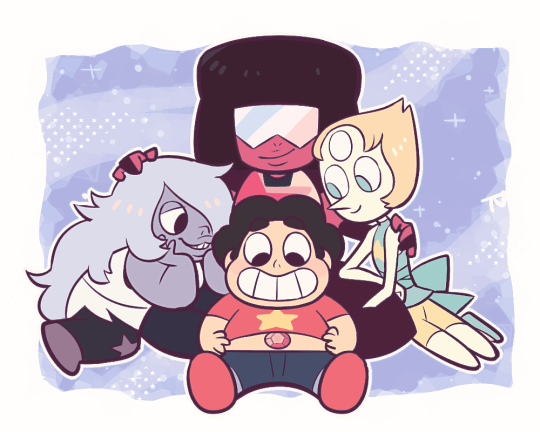
Or consider Steven Universe, which many herald as “the poster child for progressive representation.” It doesn’t hide its themes of gender fluidity and racial diversity: Steven is a chubby boy drawn in the signature CalArts style, raised by a single dad and three powerful Crystal Gems; his presumed mother is a strong, matriarchal figure; and LGBTQ storylines appear organically throughout the series. All of these elements explicitly challenge conventional family structures and identities. But what made Steven Universe widely embraced isn’t just its “labels”—it’s that it’s genuinely well-crafted, heartfelt storytelling. That distinction—“authentic expression of diversity” versus “diversity for diversity’s sake”—is key.
We saw similar tonal differences on Disney Channel and Nickelodeon as well. Disney Channel excelled at creating glossy tween hits—Phineas and Ferb, Kim Possible, and Wizards of Waverly Place still evoke fond memories of brightness, humor, and adventure. Nickelodeon leaned into the delightfully off-kilter—SpongeBob SquarePants and The Loud House, for example, let absurdity reign.
The Shift to Streaming
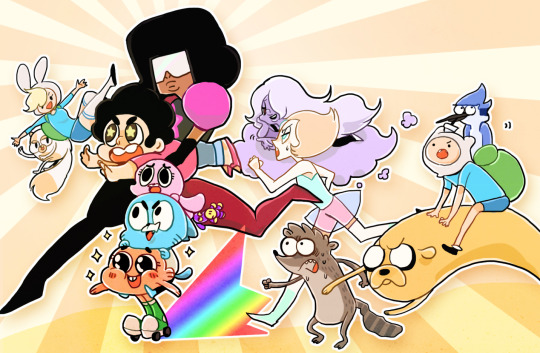
Now, Cartoon Network has quietly shuttered its official website and pivoted entirely to making content for streaming platforms. Disney Channel itself has effectively been replaced by Disney+, and Nickelodeon’s original programming increasingly lives inside Paramount+. These changes reflect the broader “industry evolution” we all know is coming.
Still, if you grew up as a “TV kid,” there’s a bittersweet ache in seeing those once–vibrant channels fade or morph. It’s not about resisting new tech—streaming is here to stay. It’s that the channels we once eagerly anticipated, talked about, and even imitated have now dissolved or merged into larger on–demand libraries.
Yes, we all know we need to move forward. Each era inevitably gives way to the next, viewing habits change, and trends come and go. But nostalgia isn’t the same as clinging to the past. Honoring what once was doesn’t mean rejecting what is. When I talk about Cartoon Network’s glory and absurdity, I’m not simply reminiscing about a childhood memory—I’m asking: where did that daring, rebellious, delightfully strange spirit go?
Is That Late–Night Soul Still Here?

Today’s animation is more segmented, more polished, more “politically correct,” and very platform–driven. In many ways, it’s higher quality than ever. But does it still have that late–night edge we loved—cartoons that felt like they could surprise you, make you think, and even unsettle you?
Some of the old Cartoon Network creators have moved on to adult animation or independent platforms, where they don’t have to “toe the family-friendly line.” They’re still satirizing, still subverting stories, but their audiences and distribution channels have changed. Maybe that’s where the true spirit of cartooning lives now—across streaming niches and late–night blocks aimed at adults.
Regardless, Cartoon Network was our friend—a patchwork of scribbled memories that defined our childhood. Even if it’s not that Cartoon Network anymore, its spirit lives on in today’s creators—albeit in new forms, telling new stories.
So here’s to hoping that spark never truly fades, no matter how many times the medium reinvents itself.
6 notes
·
View notes
Text
From Design to Deployment: How Switchgear Systems Are Built

In the modern world of electrical engineering, switchgear systems play a critical role in ensuring the safe distribution and control of electrical power. From substations and factories to commercial buildings and critical infrastructure, switchgear is the silent guardian that protects equipment, ensures safety, and minimizes power failures.
But have you ever wondered what goes on behind the scenes, from the idea to the actual installation? Let’s dive into the full journey — from design to deployment — of how a switchgear system is built.
Step 1: Requirement Analysis and Load Study
Every switchgear project begins with requirement analysis. This includes:
Understanding the electrical load requirements
Calculating voltage levels, short-circuit ratings, and operating current
Identifying environmental conditions: indoor, outdoor, temperature, humidity
Reviewing applicable industry standards like IEC, ANSI, or DEWA regulations (especially in UAE)
This stage helps engineers determine whether the project needs low voltage (LV), medium voltage (MV), or high voltage (HV) switchgear.
Step 2: Conceptual Design & Engineering
Once the requirements are clear, the conceptual design begins.
Selection of switchgear type (air insulated, gas insulated, metal-enclosed, metal-clad, etc.)
Deciding on protection devices: MCCBs, ACBs, relays, CTs, VTs, and fuses
Creating single-line diagrams (SLDs) and layout drawings
Choosing the busbar material (copper or aluminum), insulation type, and earthing arrangements
Software like AutoCAD, EPLAN, and ETAP are commonly used for precise engineering drawings and simulations.
Step 3: Manufacturing & Fabrication
This is where the physical structure comes to life.
Sheet metal is cut, punched, and bent to form the panel enclosures
Powder coating or galvanizing is done for corrosion protection
Assembly of circuit breakers, contactors, protection relays, meters, etc.
Internal wiring is installed according to the schematic
Every switchgear panel is built with precision and must undergo quality control checks at each stage.
Step 4: Factory Testing (FAT)
Before deployment, every switchgear unit undergoes Factory Acceptance Testing (FAT) to ensure it meets technical and safety standards.
Typical FAT includes:
High-voltage insulation testing
Continuity and phase sequence testing
Functionality check of all protection relays and interlocks
Mechanical operations of breakers and switches
Thermal imaging to detect hotspots
Only after passing FAT, the switchgear is cleared for shipping.
Step 5: Transportation & Site Installation
Transportation must be handled with care to avoid damage to components. At the site:
Panels are unloaded and moved to their final location
Cabling and bus duct connections are established
Earthing systems are connected
Environmental sealing is done if installed outdoors or in dusty environments
Step 6: Commissioning & Site Acceptance Testing (SAT)
This final stage ensures the switchgear is ready for live operation.
Final checks and Site Acceptance Tests (SAT) are performed
System integration is tested with other components like transformers, UPS, and generators
Load tests and trial runs are conducted
Commissioning report is generated, and documentation is handed over to the client
Conclusion
From idea to execution, the journey of building a switchgear system is highly technical, safety-driven, and precision-based. Whether you’re in power generation, industrial automation, or commercial construction, understanding this process ensures you choose the right system for your needs.
7 notes
·
View notes
Text




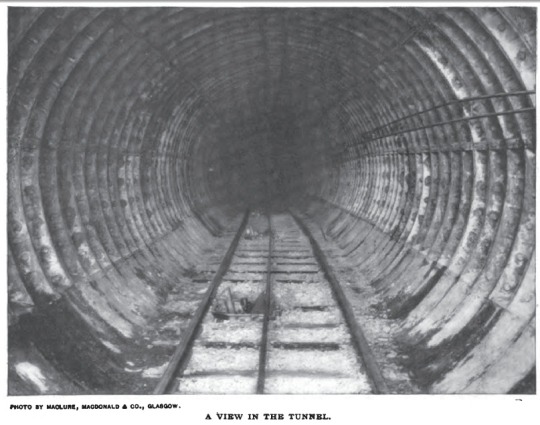

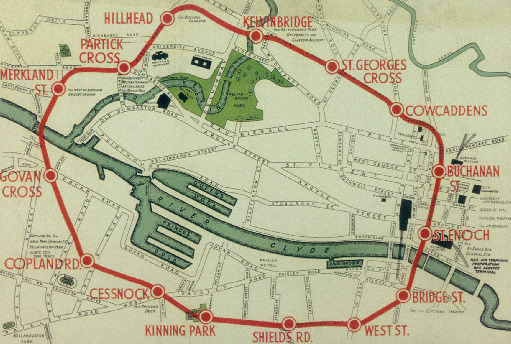

On December 14th 1896 the first carriage of the new Glasgow District Subway, as it was originally named, departed Govan Cross at 5am.
The first cars were cable-hauled and would remain so until electrification was introduced in 1935.
The brainchild of civil engineer Alexander Simpson, it had been built to serve a rapidly-expanding industrial city with a population fast approaching 1 million people.
As dawn broke it seemed the whole city was out in force and directors and officials were soon congratulating themselves on the success of their new system. However, any fist-pumping or back-slapping was to prove premature.
At around 3pm a complete breakdown occurred on the outer circle, causing momentary chaos. Stranded passengers were forced to walk along the lines back to the nearest station.
A few hours later, as normal service resumed, one man suffered a horrific foot injury as the huge swell of people forced him between the carriage and. As if that wasn’t bad enough for day one, worse followed at just before 11pm when a stationary carriage awaiting the signal to approach St Enoch Station from Bridge Street was hit by another car running at near full speed. The two carriages were carrying roughly 50 passengers each at the time of the collision and 18 were reported as seriously injured. platform.
One 14-year-old boy was rendered unconscious and taken to the Royal Infirmary, having suffered a severe cut to his left temple.
The accident made headlines up and down the UK, forcing the closure of the Subway until January the following year.
An enquiry into the collision concluded that defective electrical connections between the signals had been the cause, although private trials in the weeks leading up to the opening had failed to flag up any major issues.
The driver of the approaching car claimed that he had spotted the stationary carriage but had been unable to stop in time to prevent the collision.
Despite the accident, the vibe was mostly positive - one of the main complaints being that the number of cars available on day one had been “hopelessly inadequate”. Subway directors countered this by stating that the extreme “rush of traffic” had exceeded all expectations.
They weren’t wrong - over 9 million passengers travelled on the Glasgow Subway in its first full year of operation.
When the Subway opened, a fixed fare price of one penny allowed passengers to travel around the six and a half mile long subway as many times as they wished. Many passengers had taken full advantage of this on the inaugural day - including the 14-year-old boy who suffered the severe head injury at 11pm, who, it’s said, had been travelling round and round the system for 8 or 9 hours prior to the collision. The fixed rate was soon abolished in favour of a fare stage system to avoid future congestion.
The railway ran with little further change until 1977 when the new operators, Greater Glasgow Passenger Transport Executive, closed it for major modernisation investment. The railway in its present form reopened for operation on 16 April 1980.
The Glasgow Subway system is the only metro system never to have been expanded from its original route in 125 years, although a report published in 2018 summarised various extension plans from 1937 onwards.
Strathclyde Partnership for Transport (SPT) unveiled a £200M contract with Stadler and Ansaldo STS in 2016 for modernisation of the Subway, including new driverless rolling stock. These trains were expected to enter service after the modernisation completed in 2020; however the trains entered passenger service in December 2023. The trains were built by Stadler Rail at their factory in Altenrhein in eastern Switzerland.
The Glasgow Subway still uses a flat-fare structure rather than a distance-based fare structure. A ticket allows passengers to stay on the Subway for as long as they like.
The Subway runs from 06:30 to 23:40 Monday to Saturday and 10:00 to 18:12 on Sunday. Trains run every 6–8 minutes during off-peak periods on both Inner (Anti-Clockwise) and Outer (Clockwise) services.
The celebrated Glaswegian writer and broadcaster Cliff Hanley composed a satirical song about the pre-modernisation era Subway entitled "The Underground Song". It was popular as a stage piece performed by the comedians Rikki Fulton and Jack Milroy in their Francie and Josie act. Hanley is more famous for another song, Scotland the Brave.
The chorus of the song is:
There's Partick Cross and Cessnock, Hillhead and Merkland Street, St George's Cross and Govan Cross where all the people meet; West Street, Shields Road – The train goes round and round; You've never lived unless you've been on the Glasgow Underground
The Glasgow Subway and its adjacent public houses are the focal point of a pub crawl known as the Subcrawl. Participants buy an all day ticket, disembark at each of the 15 stations and have a drink in the nearest bar
youtube
14 notes
·
View notes
Text


SwRI is sending its first instrument to the lunar surface to survey the Moon’s interior
LMS instrument aboard the Blue Ghost Lander heading to Mare Crisium in early 2025
Through NASA’s Commercial Lunar Payload Services (CLPS) initiative, Southwest Research Institute developed the Lunar Magnetotelluric Sounder (LMS) to characterize the structure and composition of the Moon’s mantle by measuring electric and magnetic fields. The LMS instrument — manifested on the Blue Ghost lunar lander developed by Firefly Aerospace and targeted to launch on January 15, 2025 — will be the first SwRI instrument to touch the lunar surface. “For more than 50 years, scientists have used magnetotellurics on Earth for a wide variety of purposes, including to find oil, water, geothermal and mineral resources as well as to understand geologic processes such as the growth of continents,” said SwRI’s Dr. Robert Grimm, principal investigator of LMS. “The LMS instrument will be the first extraterrestrial application of magnetotellurics. NASA’s Artemis program is developing a series of increasingly complex missions to ultimately build a sustained human presence at the Moon for decades to come. To support these goals, LMS is part of a 14-day lunar lander mission to help understand the Moon’s subsurface in a previously unexplored location. Mare Crisium is an ancient, 350-mile-diameter impact basin that subsequently filled with lava, creating a dark spot visible to the naked eye on the Moon. Early astronomers who dubbed dark spots on the moon “maria,” Latin for seas, mistook them for actual seas. Mare Crisium stands apart from the large, connected areas of dark lava to the west where most of the Apollo missions landed. These vast, linked lava plains are now thought to be compositionally and structurally anomalous with respect to the rest of the Moon. From this separate vantage point, LMS may provide the first geophysical measurements representative of most of the Moon. Magnetotellurics uses natural variations in surface electric and magnetic fields to calculate how easily electricity flows in subsurface materials, which can reveal their composition and structure. LMS will allow scientists to probe the interior of the Moon to depths up to 700 miles or two-thirds of the lunar radius. The measurements will shed light on the material differentiation and thermal history of our Moon, a cornerstone to understanding the evolution of solid worlds. The LMS instrument ejects cables with electrodes at 90-degree angles to each other and distances up to 60 feet. The instrument measures voltages across opposite pairs of electrodes, much like the probes of a conventional voltmeter. The magnetometer is deployed via an extendable mast to reduce interference from the lander. The method reveals a vertical profile of the electrical conductivity, providing insight into the temperature and composition of the penetrated materials in the lunar interior. “The five individual subsystems of LMS, together with connecting cables, weigh about 14 pounds and consume about 11 watts of power,” Grimm said. “While stowed, each electrode is surrounded by a ‘yarn ball’ of cable, so the assembly is roughly spherical and the size of a softball.” The LMS payload was funded for delivery to the lunar surface through NASA’s CLPS initiative. SwRI designed the instrument, built the electronics box and leads the science investigation. Goddard Space Flight Center provided the LMS magnetometer to measure the magnetic fields, and Heliospace Corp. provided the magnetometer mast and four electrodes used to measure the electrical fields. Under the CLPS model, NASA is investing in commercial delivery services to the Moon to enable industry growth and support long-term lunar exploration. As a primary customer for CLPS deliveries, NASA aims to be one of many customers on future flights. NASA’s Marshall Space Flight Center in Huntsville, Alabama, manages the development of seven of the 10 CLPS payloads carried on Firefly’s Blue Ghost lunar lander.
TOP IMAGE: From within the Mare Crisium impact basin, the SwRI-led Lunar Magnetotelluric Sounder (LMS) may provide the first geophysical measurements representative of the bulk of the Moon. Most of the Apollo missions landed in the region of linked maria to the west (left image), whose crust was later shown to be compositionally distinct (right image) as exemplified by the concentration of the element thorium. Mare Crisium provides a smooth landing site on the near side of the Moon outside of this anomalous region. Credit NASA
LOWER IMAGE: LMSwRI led the development of the LMS instrument for the Mare Crisium lander mission, which includes (from left) a magnetometer, a central electronics box and four spring-launched electrodes. Credit Southwest Research Institute
7 notes
·
View notes
Text
Plan Incliné de Saint-Louis-Arzviller

This is going to be a rather long post as there is a lot to say about this thing! But the short version is: this is a boat lift.
Built in the 1960s, this "inclined plane" was designed to carry barges as part of the fluvial coal transportation industry. However, that trade declined pretty much during the edifice's construction, and today, it almost exclusively serves leisure boats. But if you're going to do a canal cruise, this thing gives it quite the difference!
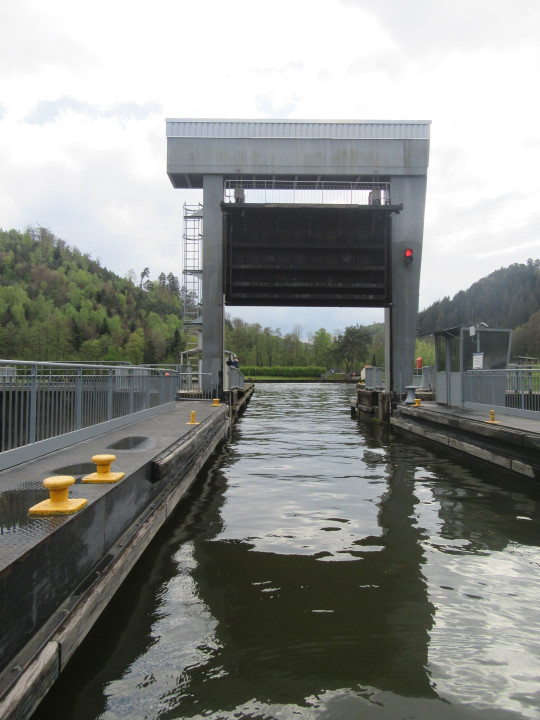
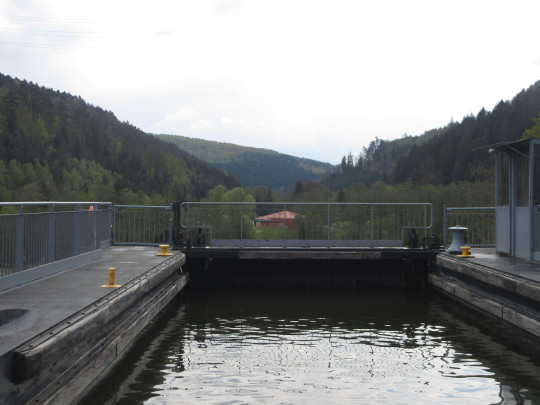
Its function is that of a lock, taking boats from the lower water level to the higher level, or vice-versa, but it does this by technically being a lift or elevator. A caisson carries the boats and the water up and down, using counterweights to ease the travel.
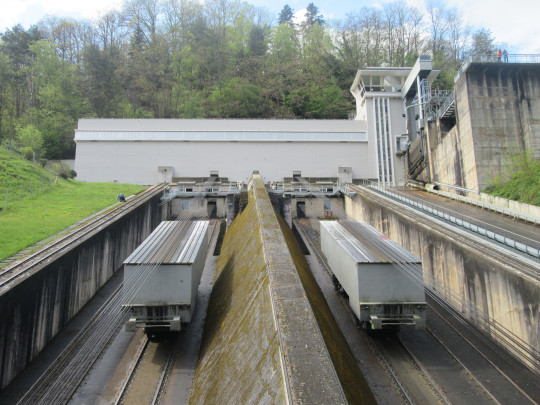
In fact, the caisson will take on more or less water in order to be heavier or lighter than the counterweights. Though the total mass of the caisson and counterweights is enormous, the difference in mass between them isn't, so very little power is needed to get the system moving, and gravity does most of the work. Two relatively modest electric motors (centre of photo below, steps to the right for scale) start the movement and control the speed.
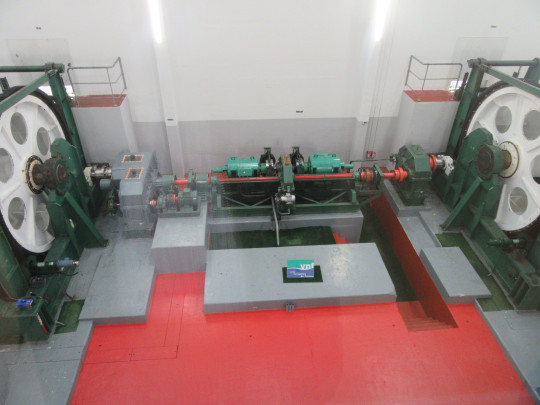
As such, the system uses comparatively little power, for impressive results. The boat lift was built to bypass a "ladder" of 17 locks which required a whole day to go through, while the travel time of the lift is just 4 minutes. The ride is seamless and very comfortable, effortless even, for reasons mentioned above but also because the effort is distributed across 5 times as many cables as physically required to hold everything together!
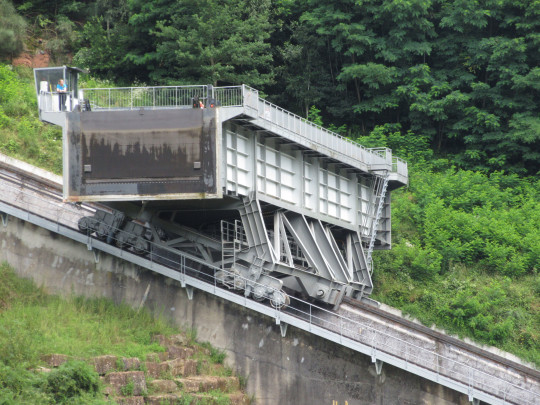
Water-tightness is also extremely important, not just for the caisson obviously, but also for the other doors, particularly the top door, which is holding back a whole length of canal. A serious incident in 2013 has led to further reinforcement of redundancies and the construction of an emergency dam closer to the lift in the event of major leaks.
With a lot of freight traffic in mind, the structure was actually designed for two caissons, side-by-side, as evidenced by a second gate hole visible at the top of the ramp (4th picture), and extra space at the bottom, visible in the final picture below. Doubling the caissons would have meant doubling the counterweights, and a second set of rails were laid for that scenario and are visible in the 4th picture. As mentioned earlier, demand dwindled as the lift was being built, so it never operated with two caissons.

For a long time, this place was a childhood memory, visited during a school trip. In my hiking spree after the 2020 and 2021 lockdowns, I sought this place out again and was glad to see it was still working. And just this week, I returned with my parents and rode the lift! It's without doubt one of my favourite pieces of engineering.
18 notes
·
View notes
Text
Flame Retardants Market demand analysis and regional outlook across key end use industries
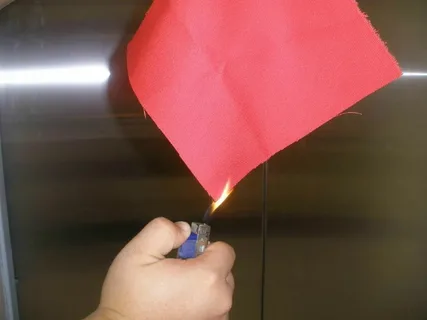
The Flame Retardants Market is expanding rapidly due to its essential role across sectors like construction, electronics, automotive, and textiles. With growing safety regulations, fire prevention measures, and technological developments, demand patterns vary notably across regions and end-use applications.
Rising Global Demand and Key Drivers
Flame retardants are crucial in preventing fire-related hazards and are increasingly used in products that require compliance with fire safety standards. Their demand is primarily driven by strict building codes, growing awareness about safety, and the rising use of electronic devices globally. Regions such as North America, Asia Pacific, and Europe are showing consistent growth, but with distinct trends and preferences.
In North America, the growth is linked to infrastructure development and industrial safety compliance. Europe shows preference for non-halogenated and eco-friendly retardants, while Asia Pacific leads in manufacturing volume, driven by strong electronics and construction markets in China, India, and Southeast Asia.
Industry-Specific Growth Patterns
Construction is a leading end-use sector for flame retardants, especially in residential and commercial buildings. Flame retardant materials like insulation, wires, cables, and structural plastics are essential for fire prevention. Demand in this sector is increasing in urbanizing regions such as Asia Pacific and the Middle East due to rising construction activities.
Electronics is another significant segment where flame retardants are used in circuit boards, housings, and connectors. As global demand for smartphones, smart TVs, and electronic vehicles grows, so does the use of flame retardants. Asia Pacific, being the hub of electronics manufacturing, is the biggest contributor here.
Automotive applications include upholstery, engine components, and electrical systems. With electric vehicles becoming mainstream, manufacturers are increasingly using flame-retardant materials to ensure passenger safety and battery protection.
Textiles represent a niche but fast-growing sector, especially for specialized garments, furniture fabrics, and industrial uniforms. The demand is rising in both developed and developing economies where fire-resistant clothing is mandated.
Regional Outlook and Market Hotspots
North America remains a mature market but shows steady demand due to regulations like the National Fire Protection Association (NFPA) codes and strong construction activity. The U.S. dominates the region’s share, followed by Canada.
Europe focuses on sustainability and safety, with strict REACH regulations and increased use of non-toxic flame retardants. Germany, France, and the UK are the leading contributors. There's a growing preference for phosphorous-based and mineral-based retardants due to environmental concerns.
Asia Pacific is the fastest-growing region, supported by expanding electronics, automotive, and textile industries. China leads in production and consumption, with India and Southeast Asia catching up rapidly. Governments in the region are also tightening fire safety norms, which is fueling further demand.
Latin America and the Middle East & Africa are emerging markets. Although smaller in size, infrastructure growth and industrial development are increasing the demand for flame retardant materials, especially in commercial real estate and energy projects.
Market Challenges and Demand Constraints
Despite the growing demand, the market faces a few constraints. Halogenated flame retardants are under scrutiny for their potential health and environmental effects, prompting stricter regulation and replacement with alternatives. Also, regional disparities in enforcement of safety standards sometimes slow market penetration in emerging areas.
Another issue is raw material volatility, which can impact pricing and production planning. For instance, supply chain disruptions in Asia Pacific or geopolitical instability in Europe may lead to fluctuating costs.
Future Outlook and Regional Forecast
The future of the flame retardants market is rooted in innovation and regional adaptability. Demand is expected to grow significantly over the next decade, with Asia Pacific continuing to dominate in volume and Europe and North America setting trends in sustainability. Emerging economies in Africa and Latin America are projected to witness stronger growth as infrastructure and industrial development accelerate.
Growth will likely be supported by rising R&D in eco-friendly compounds and a growing emphasis on safety standards across all industries. Companies that align their offerings to regional preferences—like halogen-free products in Europe or cost-effective solutions in Asia—will have a competitive edge.
Conclusion
The global flame retardants market shows strong regional diversity in demand, influenced by regulations, industrial activities, and consumer preferences. Each major end-use industry—construction, electronics, automotive, and textiles—offers unique growth opportunities that vary by region. Companies looking to succeed in this space must adapt to regional market dynamics, invest in sustainable alternatives, and align with evolving safety standards.
#FlameRetardants#ConstructionSafety#ElectronicsIndustry#FireProtection#MarketTrends#AsiaPacificGrowth#SustainableMaterials#FireSafety#MarketAnalysis#GlobalExpansion
2 notes
·
View notes
Text
Building a Reliable LV Panel? Here Are 12 Components You Can’t Overlook

Low Voltage (LV) panels are the heartbeat of modern electrical systems, ensuring safe and efficient power distribution in residential, commercial, and industrial settings. While large breakers and meters often steal the spotlight, it’s the small, often overlooked components that ensure the reliability, safety, and functionality of an LV panel.
At Daleel Trading, we proudly offer Elber Electric’s range of switchgear accessories — trusted by panel builders across the GCC for their durability and precision. In this article, we’ll explore 12 essential components that no LV panel should be without.
1. NH00 Fuse and Fuse Base
The NH00 fuse is vital for overcurrent protection. It safeguards electrical circuits from damage due to overloads or short circuits. When combined with a high-quality Elber fuse base, this setup ensures easy replacement and secure mounting, providing both safety and convenience.
Why it matters: Prevents costly equipment damage and ensures system uptime.
2. Neutral Links
Neutral links allow safe termination and distribution of the neutral wire in panelboards. Made from high-conductivity brass or copper, Elber’s neutral links ensure minimal resistance and long service life.
Why it matters: Ensures balanced load return paths and system stability.
3. Hex Spacer Bolts
These small mechanical components provide spacer and insulation between parts like busbars or mounting plates. Elber’s precision-made hex spacer bolts reduce the risk of arcing and simplify panel assembly.
Why it matters: Maintains physical separation and alignment in compact panels.
4. Busbars
Busbars act as the central conductors in LV panels, distributing power to multiple circuits. Elber provides solid, tinned copper or aluminum busbars with excellent conductivity and mechanical strength.
Why it matters: Reduces wiring clutter and minimizes voltage drops.
5. Busbar Supports
To keep busbars securely in place, high-dielectric busbar supports are used. Elber’s supports are made from thermoset materials, ensuring strength, insulation, and resistance to temperature and chemicals.
Why it matters: Prevents short circuits, mechanical sag, and electrical faults.
6. FRP Support Channels
Fiberglass Reinforced Plastic (FRP) supports are corrosion-resistant and non-conductive, making them ideal for mounting and support in harsh environments.
Why it matters: Adds structural support and insulation in demanding conditions.
7. Polycarbonate Sheet
Used as covers or barriers in LV panels, polycarbonate sheets are transparent, flame-retardant, and impact-resistant. Elber’s polycarbonate sheets allow visual inspection without compromising safety.
Why it matters: Enhances operator safety while allowing visibility and access.
8. PVC Ferrules
PVC ferrules are used to label and organize wires, preventing errors during installation or maintenance. Elber provides high-quality ferrules in multiple sizes and colors.
Why it matters: Improves wire management and speeds up troubleshooting.
9. Wire End Sleeves
Wire end sleeves (also known as bootlace ferrules) protect stranded wires from fraying and ensure secure termination in terminals. They are essential for proper current flow and long-term connection stability.
Why it matters: Prevents loose connections and improves contact quality.
10. Bakelite Sheet
These rigid, non-conductive sheets serve as insulation barriers or mounting bases. Bakelite sheets are heat-resistant and dimensionally stable — ideal for demanding electrical environments.
Why it matters: Provides electrical insulation and mechanical separation.
11. Fuse Puller
A small but critical tool, the fuse puller ensures safe and contact-free removal of fuses. Elber’s non-conductive pullers are designed for NH-type fuses and reduce the risk of electric shock.
Why it matters: Enables maintenance without power shutdown or hazards.
12. Cable Markers & Accessories
Though small, cable markers help maintain an organized system by providing clear wire identification. Elber’s markers are durable, heat-resistant, and easy to install.
Why it matters: Saves time during commissioning, inspection, and servicing.
Why These Components Matter for Panel Builders
While fuses and busbars handle the big jobs, it’s the accessories — spacers, supports, sleeves, and markers — that determine long-term reliability, safety, and serviceability. At Daleel Trading, we’ve partnered with Elber Electric because of their proven performance in demanding electrical environments.
Whether you’re building a new panel or upgrading an existing system, overlooking these components could lead to safety issues, breakdowns, or costly rework.
Ready to Build Safer, Smarter Panels?
Get in touch with Daleel Trading today for:
· Technical support on Elber products
· Fast delivery across the GCC
· Custom recommendations for your panel design
#LowVoltagePanel#SwitchgearComponents#ElectricalPanelDesign#PanelBuilding#LVPanelAccessories#ElectricalEngineering#IndustrialElectrical#ElberElectric#ElectricalSafety#FuseBase#BusbarSystems#electrical#low voltage#manufacturer#switchgear#panel#dubai#united arab emirates#1950s#60s#70s
3 notes
·
View notes
Note
Besides, outside of Angela, Jennifer, and Peter. Ryan is the most famous and active industry-wise? (no offense to the other actors but it's true). He's famous enough. He has been in like 15+ movies, acting alongside well-known actors. He has been in the main cast of two network television shows (not including 9-1-1) and has been a love interest in a popular cable teen show. Sure, he's no Angela Bassett or Jennifer Love Hewitt but he's famous enough for them to use him in promo. And he has recently been in other non-911 related articles/interviews/promo thanks to his recent movie and his upcoming one with Rosario Dawson. He's the most convenient/obvious choice not only because of Eddie but because of Ryan aswell. Ryan and Eddie just happened to perfectly align for this promo season. ABC/911 knows what they're doing. People just really need to let them do their jobs, they have been doing this for a long time. THEY KNOW WHAT THEY'RE DOING, IT'S LITERALLY THEIR JOB!
Is this another downside of streaming? Do people not know how network television works anymore? Are people studying this?
🔎 Nancy Drew
Honestly, yeah, Ryan is famous enough to be recognizable but Eddie is still his big role, so he's in that great sweet spot to be incredibly easy to market and have people pay attention. He's not HUGE. But he's known. And if Eddie has a bigger arc coming, it makes perfect sense to capitalize off of that. And yeah, people are just doing their jobs, let them.
I do think this is another casualty of streaming, maybe someone should study the effects of streaming on people's ability to deal with different structures when it comes to shows.
14 notes
·
View notes
Text
Top Tips for Fast and Safe Panel Assembly

Panel assembly is a critical process in the electrical industry that directly impacts safety, performance, and efficiency. Whether you’re building distribution panels, control boards, or switchgear systems, the goal is to assemble panels quickly without compromising safety or quality. In this post, we’ll explore proven tips to help electricians, technicians, and panel builders streamline their workflow while ensuring compliance with safety standards.
1. Plan Thoroughly Before Assembly
Efficiency starts with preparation. Before you begin, study the layout drawings and electrical schematics carefully. Make a checklist of all the required components — circuit breakers, relays, terminal blocks, wire ducts, and enclosures.
· Pre-arrange tools and materials
· Verify component compatibility with design
· Identify high-priority tasks and dependencies
A well-organized plan saves time and avoids costly errors during installation.
2. Use Modular and Pre-Fabricated Components
Using modular devices like DIN-rail mountable circuit breakers or pre-assembled terminal blocks can reduce build time significantly.
Benefits:
· Faster mounting and wiring
· Easier upgrades and replacements
· Reduced wiring complexity
Where possible, opt for plug-and-play components or pre-terminated wiring kits.
3. Maintain a Clean and Organized Work Area
A tidy workstation boosts productivity and prevents mistakes. Use labeled bins, trays, and tool organizers to keep everything accessible.
· Segregate power, control, and signal cables
· Keep fasteners and tools sorted by size/type
· Remove scrap materials and wire offcuts regularly
A clean work area also improves safety and reduces trip hazards.
4. Label Components and Wiring Clearly
Proper labeling speeds up installation and future maintenance. Use heat-resistant wire markers or automated labeling machines for consistency.
Label:
· All wires at both ends
· Control devices (relays, contactors, timers)
· Terminal blocks and busbars
Clear identification is essential for testing, fault isolation, and panel certification.
5. Use the Right Torque Tools
Over- or under-tightened terminals can cause failures or fire risks. Always use torque screwdrivers or wrenches calibrated to the manufacturer’s specifications.
· Ensure solid mechanical and electrical contact
· Reduce the risk of arcing or overheating
· Document torque settings for quality records
Following torque guidelines is a best practice for long-term reliability.
6. Apply Effective Cable Management
Good cable routing isn’t just about aesthetics — it enhances performance and safety.
· Use wire ducts, cable ties, and strain reliefs
· Maintain minimum bend radii, especially for data cables
· Separate AC power and control wiring to avoid interference
Neatly routed cables simplify inspections and future modifications.
7. Conduct Final Visual and Electrical Inspection
Before energizing the panel:
· Inspect all terminations and mounting
· Check for exposed conductors or loose parts
· Test insulation resistance and continuity
· Verify grounding and bonding paths
A comprehensive inspection reduces commissioning delays and ensures compliance with safety standards.
8. Document As-Built Changes
If any field modifications were made during assembly, update the panel drawings and documentation to reflect those changes.
Include:
· Wiring diagrams
· Component serial numbers
· Torque test records
· Electrical test results
Accurate documentation is essential for maintenance, certification, and future upgrades.
9. Train Your Assembly Team
Skilled workers build faster and safer panels. Provide regular training on:
· Electrical safety and lockout/tagout
· Schematic interpretation
· Safe use of hand and power tools
· Latest panel-building standards (e.g., IEC, UL, NEC)
An informed and competent team minimizes rework and enhances build quality.
Final Thoughts
Fast panel assembly doesn’t mean cutting corners. By following structured processes, using the right tools, and prioritizing safety, you can consistently deliver high-quality panels — on time and within budget.
Looking for top-tier switchgear accessories and panel-building solutions? Contact us today to explore how we can support your projects with reliable, efficient, and cost-effective products.
5 notes
·
View notes
Text
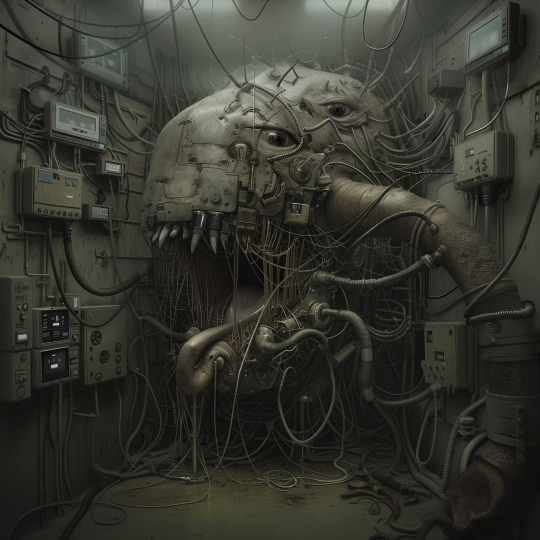
Stuck in the machine
Midjourney prompt: **The image portrays a surreal, dystopian scene featuring an enormous, grotesque mechanical monster. Its gaping maw, filled with sharp, jagged teeth and a protruding, fleshy tongue, dominates the center of the composition. The creature is integrated into a complex array of mechanical components, wires, and tubes that weave through its body and the surrounding environment. Numerous industrial elements, such as dials, switches, and meters, are embedded within the creature's structure, giving it an eerie, biomechanical appearance. The scene is dark and chaotic, with a muted color palette dominated by grays and browns, evoking a sense of decay and disorder. The background is filled with a tangle of cables and machinery, creating an oppressive, claustrophobic atmosphere. Despite the technological elements, the organic aspects of the creature, like its teeth and tongue, add a disturbing, almost nightmarish quality to the image. This fusion of flesh and machine suggests a world where technology has merged with living beings in a horrifying manner. --style raw --p k4sbz7n --v 6.0** - Upscaled (Subtle)
#Midjourney#AI#AI art#AI art generation#AI artwork#AI generated#AI image#computer art#computer generated
5 notes
·
View notes